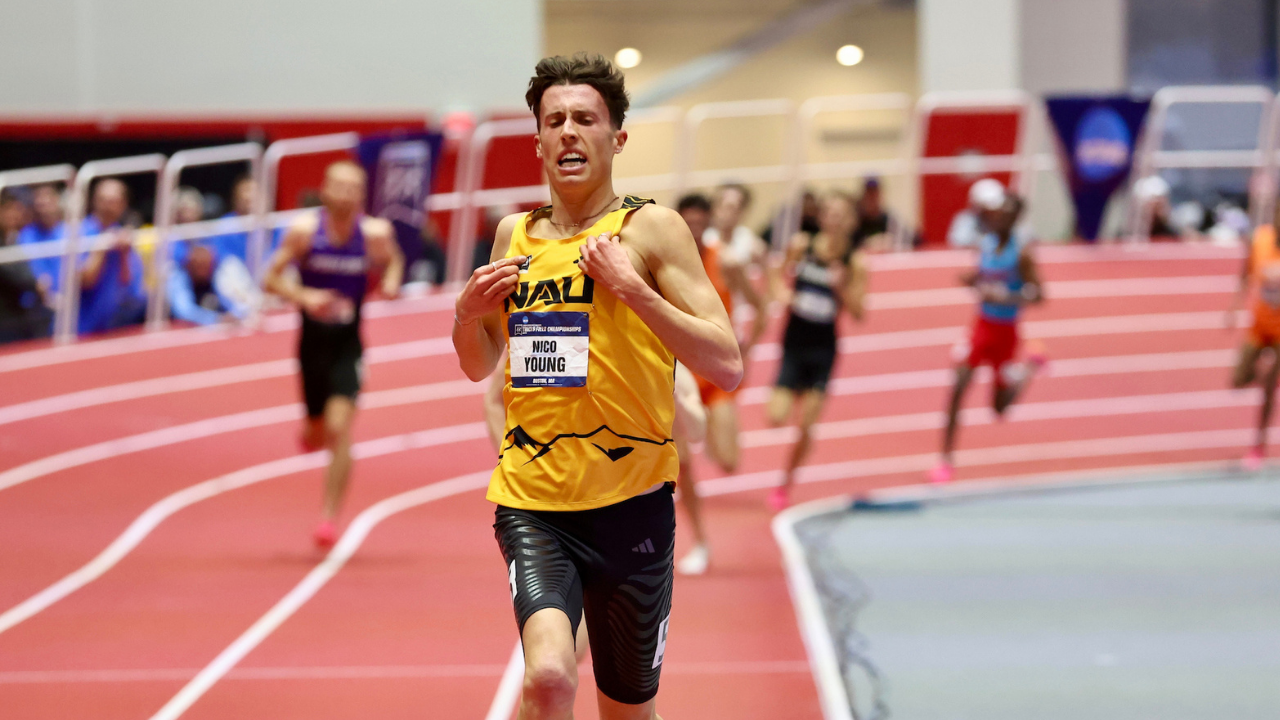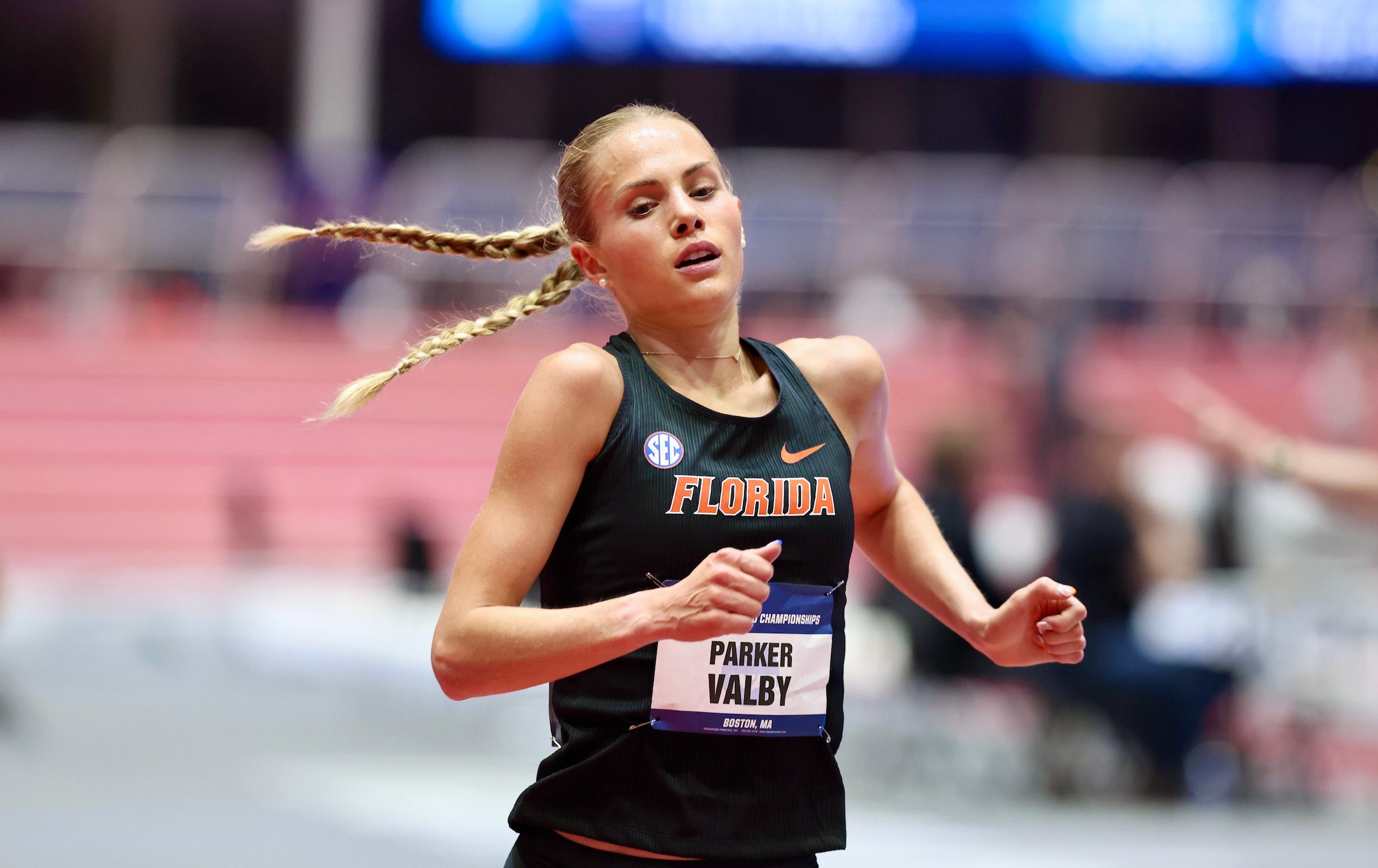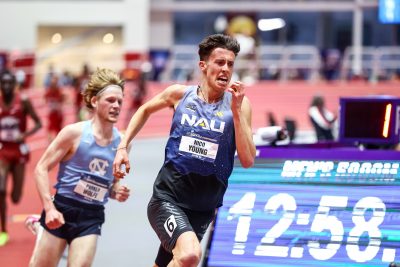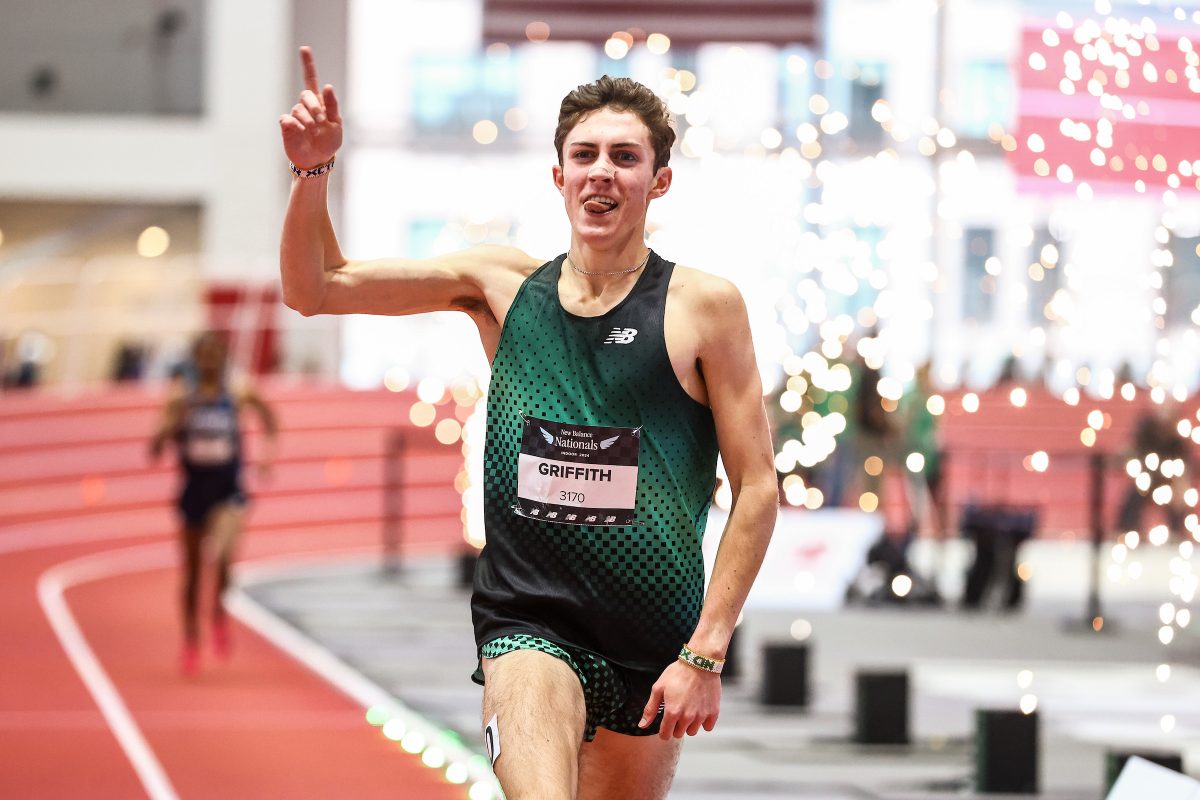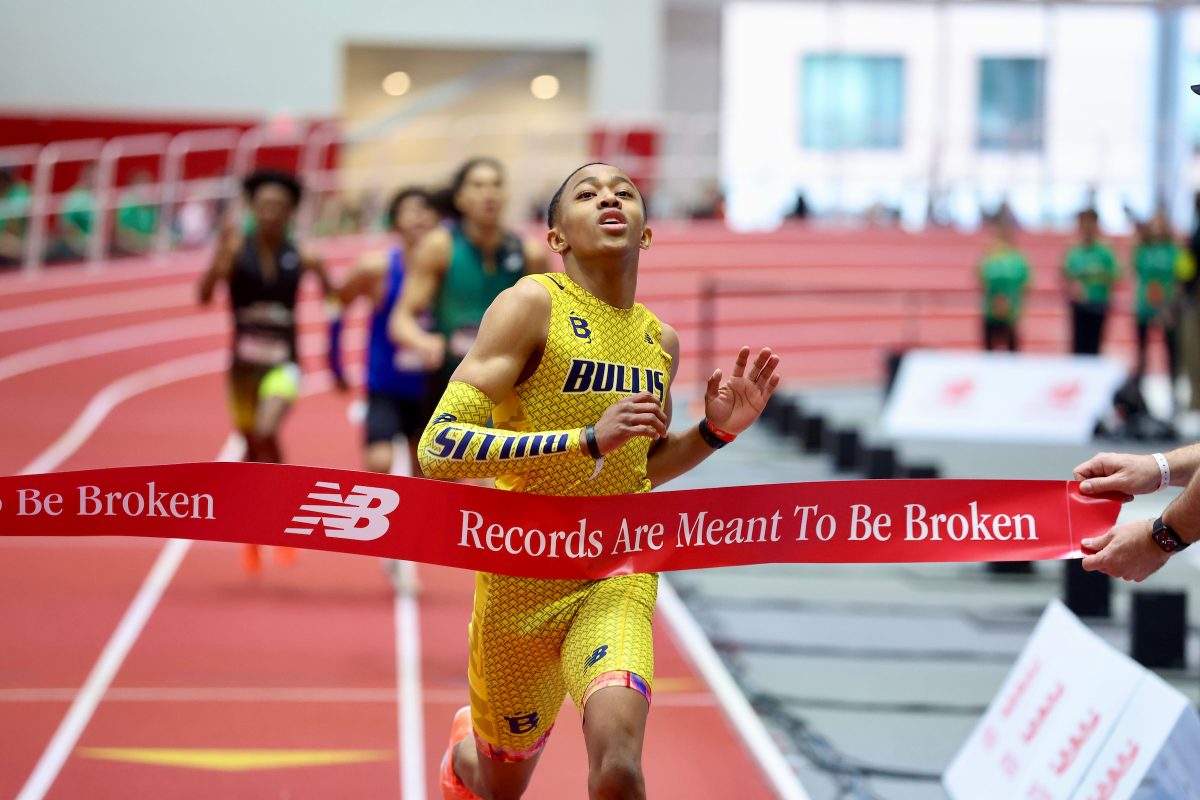WTW: Putting Nico Young & Parker Valby’s NCAA Doubles in Perspective, HS Records Galore, and Why Noah Lyles Needs to Do More to Run Olympic 4×400
By Jonathan GaultEach week, we try to make the sport more fun to follow by putting the prior week’s action in perspective for you. Past editions of our Week That Was weekly recap can be found here. Got a tip, question or comment? Please call us at 844-LETSRUN (538-7786), email us, or post in our forum.
Last week, Robert Johnson filled in for me by writing our NCAA previews while I was on vacation. This week, Rojo is the one on vacation so I’m filling in for him by writing the Week That Was.
The highlight from last weekend was the NCAA indoor championships in Boston, where Northern Arizona’s Nico Young and Florida’s Parker Valby put on a show. I discuss some final takeaways from the meet below but if you want full coverage and analysis of all the distance events, check out our NCAA coverage hub here. We also did a monster post-meet video show on Saturday night that you can watch here. LetsRun.com Supporters Club members also received the show as a podcast — just as they do every week with our bonus Friday 15 podcast. If you want an extra podcast every week, great deals on shoes and gear, and want to support LetsRun.com in the process, join the Supporters Club today.
Are you in need of a new shoe? Check out our shoe review site – BetterRunningShoes.com.
***
Putting Nico Young and Parker Valby’s dominant NCAA weekends in perspective
When the NCAA indoor championships wrapped on Saturday night, Nico Young and Parker Valby were two of the unquestioned stars of the show. Young, who earlier this year ran a 3:57 mile at 7,000 feet in Flagstaff and became the first collegian under 13:00 in the 5,000, closed out an incredible season by winning his first two NCAA titles in the 5,000 and 3,000. Valby won the same two events, which gives her four straight NCAA titles aftering winning the 5,000 in Austin in June and the cross country crown in Charlottesville in November. She has not lost to a collegiate woman in over a year.
Winning two NCAA titles in 24 hours is very impressive, but it is not rare. On the men’s side, someone has swept the 5,000 and 3,000 in seven of the past 10 years:
| Year | Athlete | School |
| 2014 | Edward Cheserek | Oregon |
| 2015 | Eric Jenkins | Oregon |
| 2016 | Edward Cheserek | Oregon |
| 2017 | Edward Cheserek | Oregon |
| 2019 | Morgan McDonald | Wisconsin |
| 2022 | Abdihamid Nur | Northern Arizona |
| 2024 | Nico Young | Northern Arizona |
On the women’s side, it has happened 50% of the time over the last 10 years:
| Year | Athlete | School |
| 2014 | Abbey Cooper | Dartmouth |
| 2016 | Molly Seidel | Notre Dame |
| 2018 | Karissa Schweizer | Missouri |
| 2023 | Katelyn Tuohy | NC State |
| 2024 | Parker Valby | Florida |
So let’s take a minute to examine the significance of Young and Valby’s performances over the weekend. Are they proof that Young and Valby are the next great American distant talents? Or are we getting carried away?
There is a case to be made that Young and Valby are generational talents. Young was one of the best high school cross country runners ever, was 4th at NCAA XC as a true freshman, and this season he has added the one tool missing from his arsenal: a finishing kick. It is reminiscent of Galen Rupp‘s transformation during his final year in Oregon at 2009. Rupp would spend the next decade becoming one of America’s greatest ever runners and contending for medals on the track and in the marathon.
Young closed both races in 1:54 for his final 800 and broke Lawi Lalang‘s meet record by running 7:41.01 in the 3,000. His winning margin of 1.37 seconds in that race was the largest since Edward Cheserek in 2014.
Valby was even more impressive, making elite runners look ordinary by comparison. Her 14:52.79 win in the 5,000 was one of the most impressive runs in collegiate history. She won the race by 22 seconds — the largest winning margin since Sally Kipyego in 2008 — and set a collegiate record in an NCAA 5,000m final while leading every step. Please get back to me when someone ever does that again.
Valby’s 14:52 meet record could stand for decades. The previous record, 15:14 by Providence’s Kim Smith, stood for 20 years, and Valby just broke that record by 20 seconds. This could be the equivalent of Henry Rono‘s NCAA outdoor meet record of 8:12 in the steeple from 1978, which still stands 46 years later.
But in all sports, we have a tendency to focus on what we just saw without considering the bigger picture. Could Young and Valby go on to long and decorated professional careers? Absolutely. But things can change quickly at the NCAA level. Nine months ago in Austin, Stanford’s Ky Robinson used sick kicks to sweep the NCAA 10,000 and 5,000 titles and we wondered how anyone could beat him moving forward. Robinson remains one of the NCAA’s best runners, but he has been beaten a number of times since then, finishing 3rd at NCAA XC and 3rd (5,000) and 5th (3,000) in Boston last weekend.
As recently as three months ago, it was Harvard’s Graham Blanks, not Young, who looked as if he would be America’s next great distance talent. Blanks went undefeated in cross country, including a win at NCAAs, then ran a collegiate record of 13:03 in December. He has not raced since due to injury. Robinson and Blanks are still great runners, but it is hard to stay on top for long.
On the women’s side, the big story this time last year was the domination of NC State’s Katelyn Tuohy, who had just ripped off the same streak of NCAA titles (outdoor-XC-indoor-indoor) that her rival Valby just accomplished. One year later, and Valby has surged ahead, soundly defeating Tuohy in their two XC meetings last fall while Tuohy has not raced since November, hinting at an injury.
It’s possible Young and Valby stay hot, win NCAA outdoors, and run their way onto this summer’s Olympic team in June. It’s also possible that this weekend was their peak for 2024. Young and Valby showed this weekend that they are special athletes when fit and healthy, but those two things can change. What if one picks up an injury this spring? What if the other wears down after a long collegiate season, as Tuohy did in 2023? Young and Valby are both just 21 years old and each could wind up as one of the defining US distance runners of the decade. Long-term, their futures are very bright. But just because they are on top of the collegiate ranks now does not mean they will stay there for the rest of the year.
On a similar note…
Will Nico Young run The TEN this weekend?
Nico Young and his coach Mike Smith have a big decision to make this week: whether to chase the Olympic 10,000m standard of 27:00 at The TEN on Saturday in California. Young has never run a 10,000 on the track, but wants to run the 10,000 at the Olympic Trials in June.
There are two ways to qualify for the Olympics in the 10,000: hit the auto standard of 27:00.00 (a time only three Americans have ever run) or qualify via world ranking. The first one offers more security. If Young runs sub-27, all he needs to do is finish in the top three at the Trials and he’s on the team. Qualifying via world ranking is more precarious because the field size is just 27 athletes. Once you account for athletes with the auto standard and the eight spots awarded to runners via cross country ranking, there might only be a couple of spots in the field available for athletes to get in via ranking. Since world ranking is based on how fast you run, Young needs to run a fast 10,000 before the Trials either way.
And there will not be a better opportunity to run a fast one than The TEN on Saturday night. The meet, organized by Sound Running, offers good weather, good pacemaking, and strong fields. The first edition of the meet was held in 2021 and since then, seven of the eight fastest 10,000s by US men (and 10 of 13) have come at The TEN. Of the nine men to make Team USA in the 10,000 in the last three years, six earned their qualifying standards at The TEN (seven if you count Sean McGorty last year, whose strong run at The TEN in 2022 gave him the necessary points to qualify via world ranking).
The problem for Young is that The TEN comes just one week after running two hard races at NCAA indoors. Smith believes Young is in shape to run around 27:00 and knows there aren’t many chances to run a fast 10,000. But he also does not want to overextend Young at the risk of his long-term development.
“Nico of course wants to do everything,” Smith told LetsRun.com. “But that’s the problem with these guys, is when you’re on top and excited, you just want to do everything. The problem with the damn 10k is it’s so hard to get those opportunities.”
The timing is unfortunate. And sub-27:00 is no guarantee even if Young runs — Grant Fisher, who has a pb of 26:33, deliberately skipped World Indoors (held a week before NCAAs) because he did not want it to affect his preparation for The TEN.
But Young is in supreme form in an Olympic year, and the Olympics are the biggest thing in our sport. Most runners only get two, maybe three Olympic Trials in their prime, and you want to make the most of those opportunities when they come.
The situation right now has a few parallels to Chris Derrick in 2012. Like Young, Derrick was a 21-year-old college kid at the time; he finished 4th in the 10,000 at the Trials while battling a plantar injury. I’ll let him pick up the story (from Derrick’s exit interview with LetsRun in 2022):
I remember sitting in my room before the Trials that year saying, God I just want to get through this and get to the next one when I’ll be healthy and ready to go. And then I remember in 2016 being in the tent when I had been hurt most of the year and petitioned to get in and knew I wasn’t in very good shape and smiled to myself like, I would take that 2012 body right now. A lesson that I’ll never get to apply but maybe someone else will would be: don’t look through any opportunity to the next one. These things are very finite and you’ve gotta take your shots while you have them.
Derrick was 5th at the ’16 Trials as a 25-year-old, DNF’d the ’20 Marathon Trials at 29, and retired at 31 having never made an Olympic team. But there’s another element to Derrick’s story. In that same interview, Derrick said he felt he damaged his chances of making the Olympic team by racing too much his senior year of college. Young has raced a bunch this indoor season and should he run The TEN on Saturday night, he will have 18,000 meters of hard racing packed into a nine-day span.
My two cents: Young should run The TEN. Sometimes you have to take risks to achieve big things in this sport. The reward of an Olympic standard on Saturday makes The TEN a risk worth taking.
***
Records galore at high school nationals
Two dueling high school national meets were held last weekend: Nike Indoor Nationals in New York and New Balance Nationals Indoor in Boston. Both produced some stellar performances.
In Boston, Foot Locker champ Drew Griffith ran 8:34.91 to set a high school record for the indoor 2-mile. Griffith had already run faster than Edward Cheserek‘s 8:39.15 from 2013 when he clocked 8:38.67 on Notre Dame’s oversize track (where he will compete next year for the Fighting Irish), but now there is no doubt about the record. That was not the only distance record to fall in Boston, as Daniel Simmons (who has committed to BYU) crushed the indoor 5,000 record of 13:56.82 by running 13:38.86.
(Side note: Wouldn’t it have been more exciting if Griffith and Simmons were in the same race? They didn’t get to race in cross country either as Griffith ran Foot Locker and Simmons NXN).
If you count Griffith’s 8:38, that means that the US high school 2-mile and 5,000 records have been broken a combined six times between indoors and outdoors since the start of last year. The previous indoor 5,000 record of 13:56.82 was set in March 2023 by Tyrone Gorze while both Connor Burns (13:37.30) and Lex Young (13:34.96) broke the outdoor record last spring. The outdoor 2-mile record remains Lukas Verzbicas‘s 8:29.46 from 2011 but three high schoolers ran 8:35 or faster last spring (Burns, Simeon Birnbaum, and Rocky Hansen).
The standout girls’ performer of the weekend was Foot Locker champ Elizabeth Leachman, who ran 9:44.16 to win the 2-mile in New York on Friday (#2 on the all-time HS indoor list behind Mary Cain‘s 9:38.68). Leachman has made breaking 9:50 look easy recently as she also ran 9:45, 9:46, and 9:43 outdoors for 3200m during a 15-day span in February. One day after her 9:44 in New York, Leachman came back to run 15:28.90 in the 5,000, taking down Katelyn Tuohy’s high school indoor record of 15:37.12. Leachman is still only a sophomore, just as Tuohy was when she set the record in 2018.
Sprinter Quincy Wilson also had a remarkable weekend. Wilson ran 45.76 to win the 400 in Boston on Sunday, breaking Elzie Coleman‘s 20-year-old national record of 45.92. His time would have placed him 4th at World Indoors two weeks ago. And if that was not enough, Wilson came back three hours later and split 46.87 to anchor his Bullis (Md.) squad to victory in the 4×400 — also in a national record time of 3:11.87. The scary thing is that Wilson, who was born in January 2008, is still just a 16-year-old sophomore.
***
Noah Lyles must do more to prove he belongs on US Olympic 4×400 team
Wilson’s run in Boston reminded me of something Noah Lyles said in Glasgow after running the third leg for the US’s silver-medal winning team at World Indoors. Lyles split 45.68 in that race and felt that proved that he is worthy of a spot on the Olympic 4×400 team come Paris, where Lyles is hoping to win four gold medals.
“I wanted to make sure that I could show everybody that I was fit so we get to Paris and I believe that I’m in shape and sharp enough that I can actually be on that 4×400 finals,” Lyles said. “…It was a situation where I was either going to be able to prove it here or we were going to go to Tom Jones or Florida Relays and run a 400 there. But now that I feel we’ve been able to prove ourselves here, we’re going to leave that as it is, knowing that as the season goes on, I will get stronger and faster.”
Noah invited select media to his training base in Orlando this past week and told Wejo (LetsRun.com co-founder Weldon Johnson), “Running a 400 at like Tom Jones or Florida Relays has been in the talks. It definitely has. But we don’t know yet. Because maybe this is enough. Maybe saying that, ‘Hey, if I’m running this fast and we haven’t even got to the peak of my career,’ maybe that’s enough belief for them.”
Sorry Noah, but you have to do more. If USATF men’s relay coach Mike Marsh puts Lyles on the Olympic 4×400 squad based off of his run in Glasgow, he is out of his mind. Lyles’ 45.68 was only the third-fastest split among Americans in Glasgow, and that team did not include any of the Americans who won gold in the 4×400 in Budapest last summer (Quincy Hall, Vernon Norwood, Justin Robinson, Rai Benjamin).
The fact is, there are tons of Americans who can split 45.68 right now in a 4×400. It’s just that most of them are either in college (or high school in the case of the 16-year-old Wilson) or aren’t running indoors. At NCAAs last weekend in Boston, 10 Americans split faster than 45.68 in the 4×400. Do you know how many Americans ran faster than 45.68 in the open 400 last year outdoors? Forty-two.
(Yes, indoors is slower than outdoors, but relay legs are also faster than open races).
Subbing in Lyles for the final at World Indoors to try to provide a boost was a defensible decision. But it does not make sense to do the same in Paris with a much stronger relay pool. If Lyles wants a shot at four medals in Paris, he either needs to run sub-45 outdoors or try to get himself onto the mixed-gender relay team. But considering the mixed-gender 4×400 final is the night before the 100m final, that’s not a great idea.
***
The Japanese Olympic marathon teams are set
Starting in 2020, Japan introduced a new way of picking its Olympic marathon team. There would be a trials race in the fall — the Marathon Grand Championship — with the top two finishers clinching berths on the team. The third-placer’s spot was tenuous: if someone ran faster than a specific target time in one of Japan’s winter/spring marathons, they could steal the third spot. If not, it went to the third placer from the trials.
You can debate whether the American or Japanese system is better, but one thing is certain: both produce plenty of drama. The Japanese domestic marathon season is now complete, and while the top three finishers from the men’s trials will be on the team (Naoki Koyama, Akira Akasaki, and Suguru Osako), there was a shakeup on the women’s side. Yuka Suzuki and Mao Ichiyama were already on the team, but if someone could run faster than 2:21:41 this spring, they would bump third placer Ai Hosoda off the team.
And in Nagoya on Sunday, not one but two Japanese women ran faster than that: Yuka Ando, who won the race in 2:21:18, and Ayuko Suzuki, who was 3rd in 2:21:33. The problem for them was that Honami Maeda ran 2:18:58 in Osaka in January to break the Japanese record. So the 2024 women’s Olympic team will be Yuka Suzuki, Ichiyama, and Maeda.
Japan’s system creates more interest in their domestic marathons, which is the goal. But for this year at least, a similar system would have ruined the US Olympic Marathon Trials. In both the men’s and women’s races in Orlando, the top two were clear of the field but there was major drama for third place in the final miles. That drama would not have been as intense if we knew those spots could be taken. Plus could you imagine if super underdog Dakotah Lindwurm finished 3rd only to be kicked off a month later because Betsy Saina ran 2:19:17 in Tokyo?
***
Sifan Hassan commits to World XC as the fields start to take shape
We are less than three weeks away from the World Cross Country Championships, which will be held on March 30 in Belgrade, Serbia, and the fields are coming together. (LetsRun.com will have boots-on-the-ground coverage, as always). USATF named its team last week and as expected, US champ Cooper Teare is not on it. Morgan Pearson, who was 4th at the trials, was the other man to decline his spot as he gears up for the Olympics in the triathlon. The top six finishers from the women’s race at USA XC, led by national champ Weini Kelati, are all running Worlds.
Internationally, the last two men’s individual champions are returning as Uganda Athletics Federation president Dominic Otucet confirmed both Joshua Cheptegei and Jacob Kiplimo will be running in Belgrade. Kiplimo and Cheptegei went 1-3 last year in Bathurst and silver medalist Berihu Aregawi of Ethiopia should be back as well as he finished 3rd at the Ethiopian trials in January.
Kenya should have a strong team as usual. World Half champ Sabastian Sawe won the men’s trials on March 2, and Ishmael Kipkirui, who won the U20 race at World XC last year, should step up to the senior team this year as he was 6th. Two-time World XC champ Geoffrey Kamworor was 4th in the trials, but his agent Valentijn Trouw told LetsRun.com Kamworor won’t run in Belgrade as he is focusing on the London Marathon on April 21.
Kenya’s women’s team is even stronger. Trials winner Agnes Ngetich, who was 3rd at 2023 World XC, has been in incredible form this year, running a world record of 28:46 for 10k on the roads of Valencia in January. Emmaculate Anyango was 2nd at the trials, just as she was in Valencia, where she ran 28:57. Kenya’s team is so good that reigning World XC champ Beatrice Chebet, who ran 14:05 for 5,000 in September, was only 4th at their trials.
The biggest name in the women’s race is Sifan Hassan: World Athletics announced Saturday that Hassan will race in Belgrade just 27 days after running 2:18:05 for 4th at the Tokyo Marathon. Surprisingly for a woman who is famously up for anything, Hassan has never run World XC; her last cross country race came in December 2015, when she won the European title in Hyères, France. Though she does have some cross country experience in Belgrade: Hassan won the U23 race when the city hosted the European champs in 2013.

